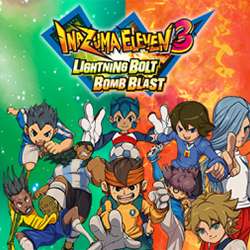Inazuma Eleven 3
| Inazuma Eleven 3 | |
|---|---|
 Art for the Lightning Bolt/Bomb Blast versions | |
| Developer(s) | Level-5 |
| Publisher(s) | |
| Director(s) | Takehiro Fujii |
| Producer(s) | Akihiro Hino |
| Composer(s) |
Yasunori Mitsuda Natsumi Kameoka |
| Series | Inazuma Eleven |
| Platform(s) | Nintendo DS, Nintendo 3DS |
| Release date(s) |
Nintendo DS
Nintendo 3DS
|
| Genre(s) | Role-playing video game/sports |
| Mode(s) | Single-player, multiplayer |
Inazuma Eleven 3 (イナズマイレブン3 世界への挑戦!! Inazuma Irebun 3: Sekai e no Chousen, lit. "Inazuma Eleven 3: Challenge to the World") is a role-playing video game and sports video game for the Nintendo DS developed and published by Level-5. There are 3 versions of the game: Spark and Bomber, released on July 1, 2010 in Japan, followed in December 16, 2010 by The Ogre. The Nintendo DS versions were never released outside Japan.
All three versions of this game were included in an updated re-release compilation titled "Inazuma Eleven 1-2-3: Endo Mamoru's Legend" for the Nintendo 3DS, released on December 27, 2012 exclusively in Japan. They were later released separately in Europe both digitally and physically, as "Lightning Bolt" (originally "Spark") and "Bomb Blast" (originally "Bomber") in Europe on September 27, 2013. The release of the third version, as "Team Ogre Attacks!", followed on February 13, 2014.
Plot
Coach Hibiki gathers Japan's greatest football players from all over Japan (many of these players are featured in the first 2 seasons). The team (below) is mainly made up of players from Raimon/The Ultimate Eleven and Aliea Academy, however there is the inclusion of Sakuma from Teikoku Academy and Hijikata. There are also two newcomers to this game which are Utsunomiya Tormaru and Tobitaka Seiya.
The players divide into 2 teams. One led by Endou and the other by Kidou. At the end of the game (In the anime) Endou's team wins by 3-2, including goals from Hiroto, Gouenji, Someoka, Reize and Fubuki. However, many of Kidou's team managed to make the team anyway, including Fudou, Gouenji, Tachimukai and Kidou himself. When the practice match is over Inazuma Japan's new coach is revealed to be Kudou Michiya and his daughter Fuyuka decides to become a manager for Inazuma Japan. Later the draw for the Asia preliminary matches is done, revealing that Japan had drawn against one of the favorites: Australia's team, Big Waves. With 2 days until the game with Australia, coach Kudou refuses to allow the team to practice and they must stay inside all day! However Tsunami manages to escape and perfects a new hissatsu technique "The Typhoon" which he uses to score past Australia.
But the rest of the players had to resort to practicing in their rooms. We discover that this is what coach Kudou had wished for the team to do in order to beat Australia's Box-Lock Defence, this allowed them to beat this by practicing in such a tight confined space such as a room, for them to be able to keep close control of the ball, the player to realize this first is Kidou. This game finished 2-1 to Japan thanks to Gouenji's newly discovered hissatsu technique "Bakunetsu Screw".
Development
At Japan Expo 2013, producer Akihiro Hino confirmed that the "Spark" (renamed "Lightning Bolt") and "Bomber" (renamed "Bomb Blast") versions would be released for Nintendo 3DS in Europe on September 27, 2013. The third version (renamed "Team Ogre Attacks!") was also announced during the Nintendo Direct on November 13, 2013, and was released on February 13, 2014.
References
External links
- Official website (
 Page will play audio when loaded)
Page will play audio when loaded)